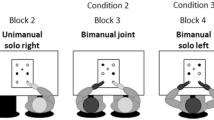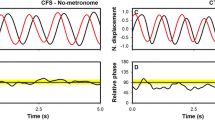Abstract
A model is proposed for the timing of rapid bimanual movements. It combines (a) the notion of a generalized motor program (GMP) with invariant relative timing, (b) the two-level concept of timing control with a central level of control and a peripheral level where the observations are made, and (c) the hypothesis that a single GMP simultaneously controls both limbs. Our method is based on the analysis of temporal intervals measured among landmarks taken from the bimanual kinematic traces. We show that sets of tetrad ratios — each composed of two pairs of covariances among four temporal intervals in the actions — should be equal to 1.0 if the hypothesis is correct. In addition, we show that these tetrad ratios should deviate systematically from 1.0 under certain, biologically realizable violations of the model. Data from human subjects show that the results generally conform to the basic model. Simulations are used to illustrate other violations of the model and to explore characteristics of the sampling distribution of the tetrad ratios under the model.
Similar content being viewed by others
References
Carson RG, Elliott D, Goodman D, Thyer L, Chua R, Roy EA (1993) The role of impulse variability in manual-aiming asymmetries. Psychol Res 55:291–298
Corcos DM (1984) Two-handed movement control. Res Q Exerc Sport 55:117–122
Cruse H, Dean J, Heuer H, Schmidt RA (1990) Utilization of sensory information for motor control. In: Neumann O, Prinz W (eds) Relationships between perception and action: current approaches. Springer, Berlin Heidelberg New York, pp 43–79
Deutsch D (1983) The generation of two isochronous sequences in parallel. Percept Psychophys 34:331–337
Gentner DR (1982) Evidence against a central control model of timing in typing. J Exp Psychol [Hum Percept Perform] 8:793–810
Gentner DR (1987) Timing of skilled motor performance: tests of the proportional duration model. Psychol Rev 94:255–276
Ghodsian D, Schmidt RA, Heuer H (1993) Generalized motor programs as a basis for two-hand coordination. Paper presented at the NASPSPA annual meeting, Brainerd, Minnesota
Grillner S (1981) Control of locomotion in bipeds, tetrapods, and fish. In: Brooks B (eds) Handbook of physiology, sect 1, The nervous system, vol II, Motor control, part 2. American Physiological Society, Bethesda MD, pp 1179–1236
Heuer H (1988) Testing the invariance of relative timing. Comment on Gentner (1987). Psychol Rev 95:552–557
Heuer H (1991) Invariant relative timing in motor-program theory. In: Fagard J, Wolff PH (eds) The development of timing control and temporal organization in coordinated action: invariant relative timing, rhythms and coordination North-Holland, Amsterdam, pp 37–68
Heuer H, Schmidt RA (1988) Transfer of learning among motor patterns with different relative timing. J Exp Psychol [Hum Percept Perform] 14:241–252
Jagacinski RJ, Marshburn E, Klapp ST, Jones MR (1988) Tests of parallel versus integrated structure in polyrhythmic tapping. J Mot Behav 20:416–442
Kelso JAS, Southard DL, Goodman D (1979) On the coordination of two-handed movements. J Exp Psychol [Hum Percept Perform] 5:229–238
Klapp ST (1979) Doing two things at once: the role of temporal compatibility. Memory Cogn 7:375–381
Klapp ST (1981) Temporal compatibility in dual motor tasks. II. Simultaneous articulation and hand movements. Memory Cogn 9:398–401
Klapp ST, Hill M, Tyler J, Martin Z, Jagacinski R, Jones M (1985) On marching to two different drummers: perceptual aspects of the difficulties. J Exp Psychol [Hum Percept Perform] 11:814–828
Konzern PB (1987) Extended practice and patterns of bimanual interference. Unpublished doctoral dissertation, University of Southern California
Marteniuk RG, MacKenzie CL (1980) A preliminary theory of two-hand coordinated control. In: Stelmach GE, Requin J (eds) Tutorials in motor behavior. North-Holland, Amsterdam, pp 185–197
Meyer DE, Smith JEK, Wright CE (1982) Models for the speed and accuracy of aimed movements. Psychol Rev 89:449–482
Norman RW, Komi PV (1979) Electromechanical delay in skeletal muscle under normal movement conditions. Acta Physiol Scand 106:241–248
Peters M (1977) Simultaneous performance of two motor activities: the factor of timing. Neuropsychologica 15:461–465
Repp BH (1994) Relational invariance of expressive microstructure across global tempo changes in music performance: an exploratory study. Psychol Res 56:269–284
Schmidt RA (1975) A schema theory of discrete motor skill learning. Psychol Rev 82:225–260
Schmidt RA (1980) On the theoretical status of time in motor-program representations. In: Stelmach GE, Requin J (eds) Tutorials in motor behavior. North-Holland, Amsterdam, pp 145–165
Schmidt RA (1985) The search for invariance in skilled movement behavior. Res Q Exerc Sport 56:188–200
Schmidt RA (1988) Motor and action perspectives on motor behavior. In: Meijer OG, Roth K (eds) Complex movement behaviour. ‘The’ motor-action controversy. North-Holland, Amsterdam, pp 3–44
Schmidt RA, Zelaznik HN, Hawkins B, Frank JS, Quinn JT (1979) Motor-output variability: a theory for the accuracy of rapid motor acts. Psychol Rev 86:415–451
Schmidt RA, Sherwood DE, Zelaznik HN, Leikind BJ (1985) Speed-accuracy tradeoffs in motor behavior: theories of impulse variability. In: Heuer H, Kleinbeck U, Schmidt K-H (eds) Motor behavior: programming, control, and acquisition Springer, Berlin Heidelberg New York, pp 79–123
Schneider DM, Schmidt RA (1995) Units of action in motor control: role of response complexity and target speed. Hum Perform 8:27–49
Spearman C (1927) The abilities of man. Macmillan, New York
Spijkers W, Heuer H, Wallmeyer P (1993) Interferenzen bei symmetrischen beidhändigen Bewegungen. Paper presented at the 35th Tagung experimentell arbeitender Psychologen, Münster, Germany
Stucchi N, Viviani P (1993) Cerebral dominance and asynchrony between bimanual 2-D movements. J Exp Psychol [Hum Percept Perform] 19:1200–1220
Summers JJ, Todd JA, Kim YH (1993) The influence of perceptual and motor factors on bimanual coordination in a polyrhythmic tapping task. Psychol Res 55:107–115
Summers JJ, Rosenbaum DA, Burns BD, Ford SK (1993) Production of polyrhythms. J Exp Psychol [Hum Percept Perform] 19:416–428
Swinnen S, Walter CB, Shapiro DC (1988) The coordination of limb movements with different kinematic patterns. Brain Cogn 8:326–347
Swinnen S, Walter CB, Lee TD, Serrien DJ (1993) Acquiring bimanual skills: contrasting forms of information feedback for interlimb decoupling. J Exp Psychol [Learn Mem Cogn] 19:1328–1344
Vorberg D, Hambuch R (1978) On the temporal control of rhythmic performance. In: Requin J (eds) Attention and performance VII. Erlbaum, Hillsdale, NJ, pp 535–555
Vorberg D, Hambuch R (1984) Timing of two-handed rhythmic performance. Ann NY Acad Sci 423:390–406
Vorberg D, Wing AM (1994) Modelle für Variabilität und Abhängigkeit bei der zeitlichen Steuerung. In: Heuer H, Keele SW (eds) Enzyklopädie der Psychologie C II 3: Psychomotorik. Hogrefe, Göttingen, pp 223–320
Walter CB, Swinnen SP (1992) Adaptive tuning of interlimb attraction to facilitate bimanual decoupling. J Mot Behav 24:95–104
Wing AM, Kristofferson AB (1973) The timing of interresponse intervals. Percept Psychophys 13:455–460
Woodworth RS (1899) The accuracy of voluntary movement. Psychol Rev 3 [Suppl 2]
Woodworth RS (1903) Le mouvement. Doin, Paris
Young DE, Schmidt RA (1990) Units of motor behavior: modifications with practice and feedback. In: Jeannerod M (eds) Attention and performance XIII. Erlbaum, Hillsdale, NJ, pp 763–795
Young DE, Schmidt RA (1991) Motor programs as units of movement control. In: Badler NI, Barsky BA, Zeltzer D (eds) Making them move: mechanics, control, and animation of articulated figures. Morgan Kaufman, San Mateo, Calif, pp 129–155
Zelaznik HN, Schmidt RA, Gielen CCAM (1986) Kinematic properties of rapid aimed hand movements. J Mot Behav 18:353–372
Author information
Authors and Affiliations
Rights and permissions
About this article
Cite this article
Heuer, H., Schmidt, R.A. & Ghodsian, D. Generalized motor programs for rapid bimanual tasks: a two-level multiplicative-rate model. Biol. Cybern. 73, 343–356 (1995). https://doi.org/10.1007/BF00199470
Received:
Accepted:
Issue Date:
DOI: https://doi.org/10.1007/BF00199470




